After an excellent meal at the Lin Heung Tea House in Hong Kong, we went down to one of the main streets and there caught a double-decker bus where we managed to find free seats in the first row of the upper deck and this time we rode for over half an hour going to the north-east part of the city area of Kowloon.
There we wanted to visit the Nan Lian Garden, as well as the Chi Lin Nunnery. Still, when we got off the bus we were completely puzzled, for we had no clue as to which way to go. Luckily, we came across a young woman pushing a pram, we asked her about the garden and she just said she would take us there. Then she turned the pram in the other direction and started to lead us at a rather fast pace. After almost 10 minutes we reached the garden where we thanked the woman and with a broad smile on her face she turned again and went back in the direction from which we had just come.
The Nan Lian Garden was made in the Tang dynasty style and was opened for visitors in 2006. As you are approaching its gates, you can already feel serenity, and you can see the beauty of the trees growing in it and the harmonious arrangement of the stones placed there, all of this followed by discreet soft music that would be ideal for meditation and relaxation.
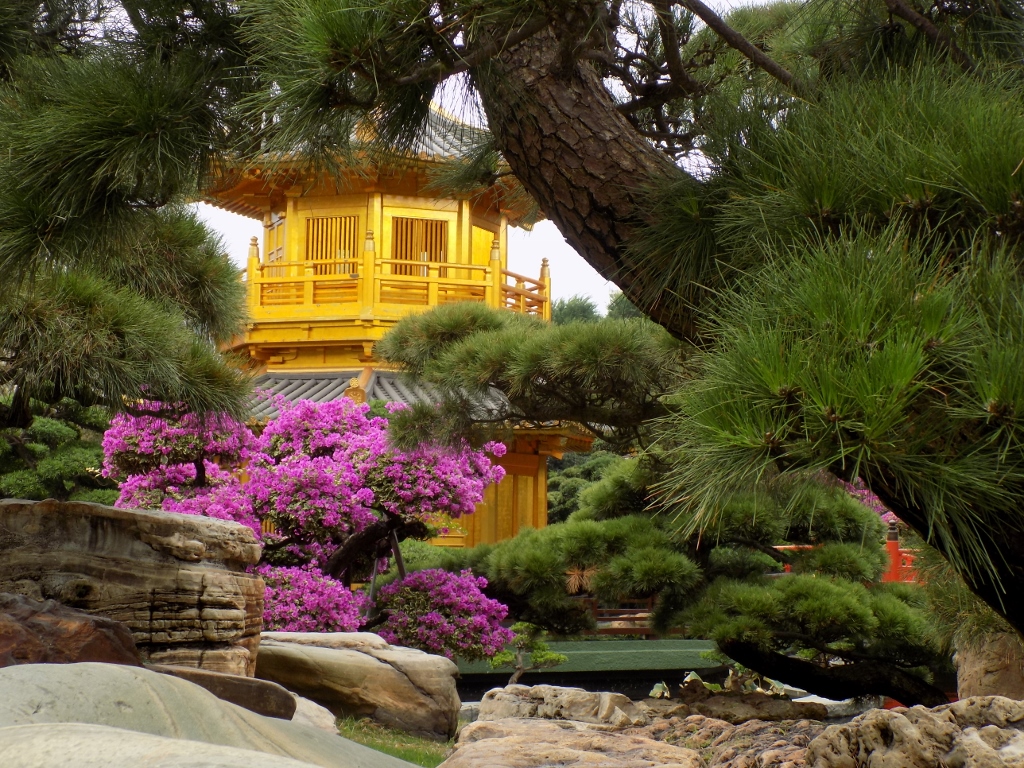 Nan Lian Garden
Nan Lian Garden
This is indeed a beautiful garden filled with harmony and yet one cannot forget that it is located in a large and busy city, which has to have high-rise buildings in order to accommodate all of its inhabitants. Wherever you go around the garden, which is not small – almost 4 hectares, you see tall buildings everywhere surrounding this pleasant core.
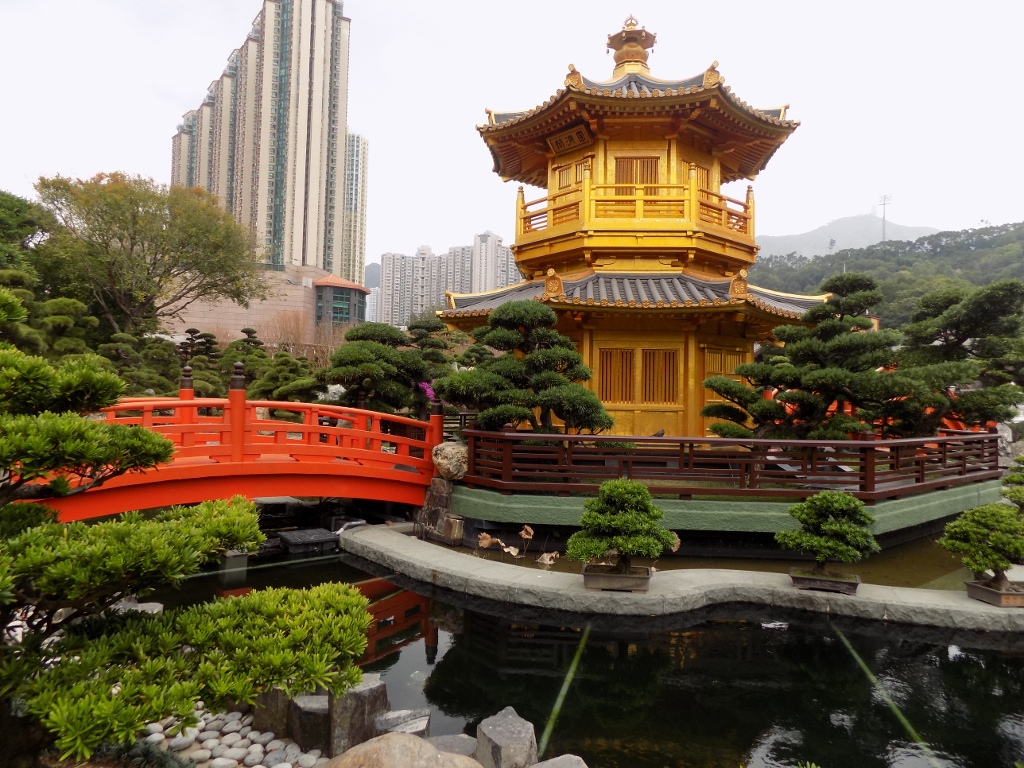 Nan Lian Garden
Nan Lian Garden
We really enjoyed our time here and our visit was made complete by going through a pavilion that exhibited works of some masterful potters. I do amateur pottery and although my personal attainments are limited, I know enough to be able to appreciate great artistic and skilful creations.
There are several pavilions in the garden. One of them contains a tea-room where you can choose quite exclusive types of teas, but first you have to take your shoes off and leave them in front of the entrance, plus it is not allowed to take photos inside. So, where is the pleasure in that???!!!
 Nan Lian Garden, a tea-room at the shore of the lake
Nan Lian Garden, a tea-room at the shore of the lake
In addition to the trees growing around the garden, in one section it is possible to see numerous bonsai trees. On the one hand, I find it completely appalling that trees are tied with wires from their earliest age, in other words from the level of being “baby” trees, that they are cut, prevented in all possible ways from growing naturally and to my mind subjected to horrible torture. In my opinion, it is an absolute equal to the unfortunate tying of feet of the poor Chinese girls only to keep them tiny, just because somebody found it attractive. After all, this barbarian practice stopped a long time ago now and the Chinese women have the freedom to have their feet as big as God has intended. And yet, as for bonsai trees, when I see some of the specimens, I can’t help feeling certain type of admiration, as if being in front of a great artistic work. And I always feel this contradiction inside of me. (By the way, this was just a beginning. Not only Hong Kong, but all of Vietnam was also full of bonsai trees.)
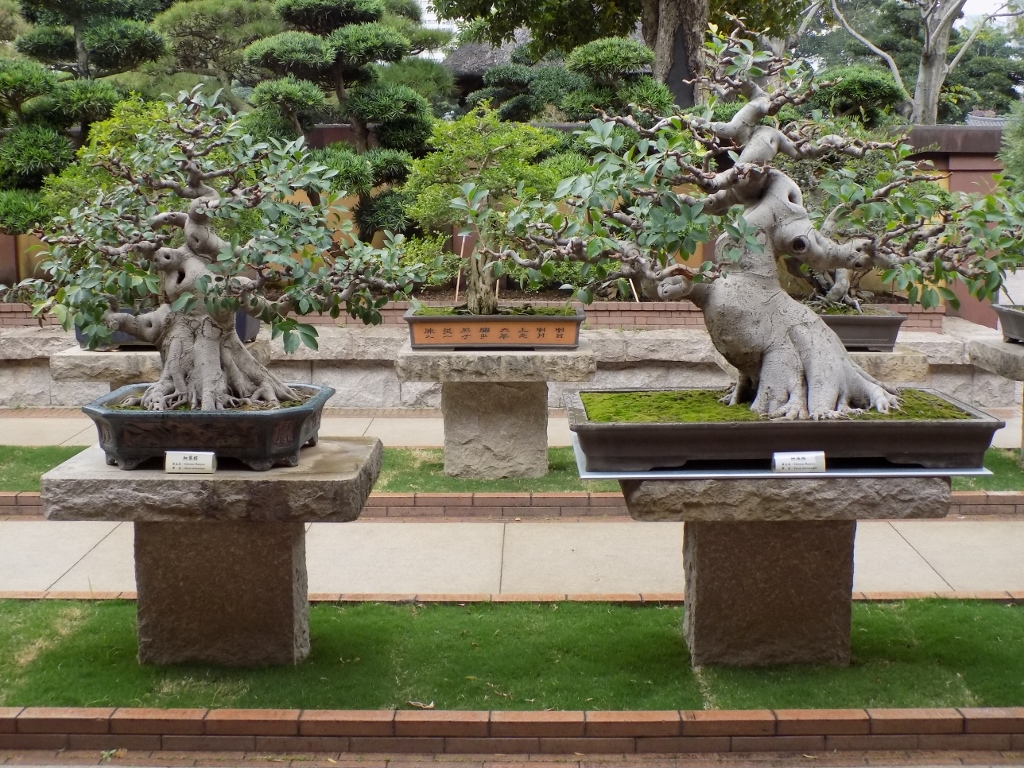 Nan Lian Garden, bonsai trees
Nan Lian Garden, bonsai trees
Needless to say, the garden is also full of trees in their natural size, but even those trees are shaped up very carefully.
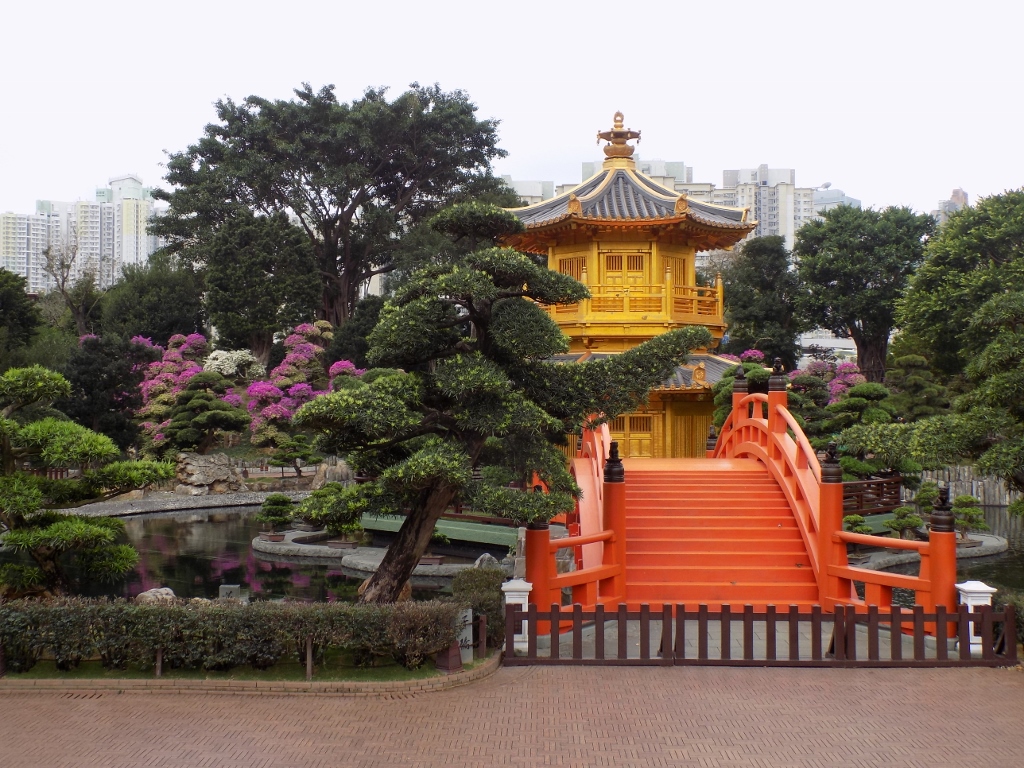 Nan Lian Garden, a detail
Nan Lian Garden, a detail
After the Nan Lian Garden we moved to the Chi Lin Nunnery that extends from the Garden and there we were taken by the beauty of the first interior courtyard that we entered. Unfortunately, the central part of the monastery had already been closed for visits, but what we did manage to see was beautiful indeed. There is a pond with lotuses, bonsai trees, as well as birds, although the nunnery is also in the middle of a busy city full of noise and traffic.
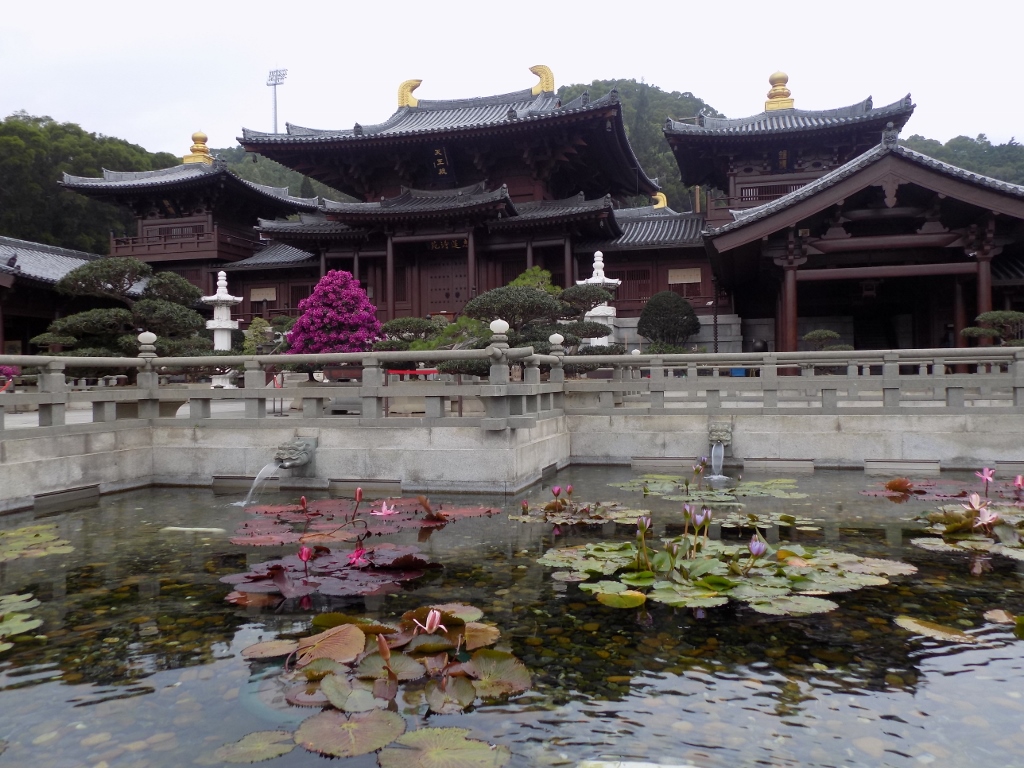 Chi Lin Nunnery
Chi Lin Nunnery
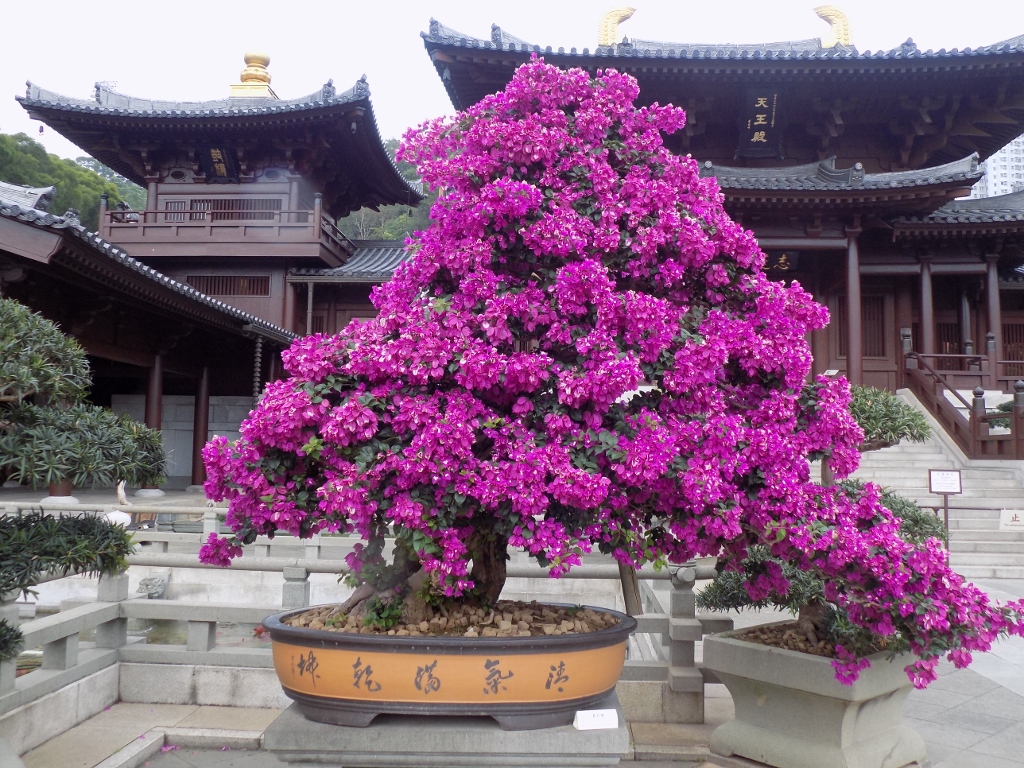 Chi Lin Nunnery, bonsai Bougainvillea
Chi Lin Nunnery, bonsai Bougainvillea
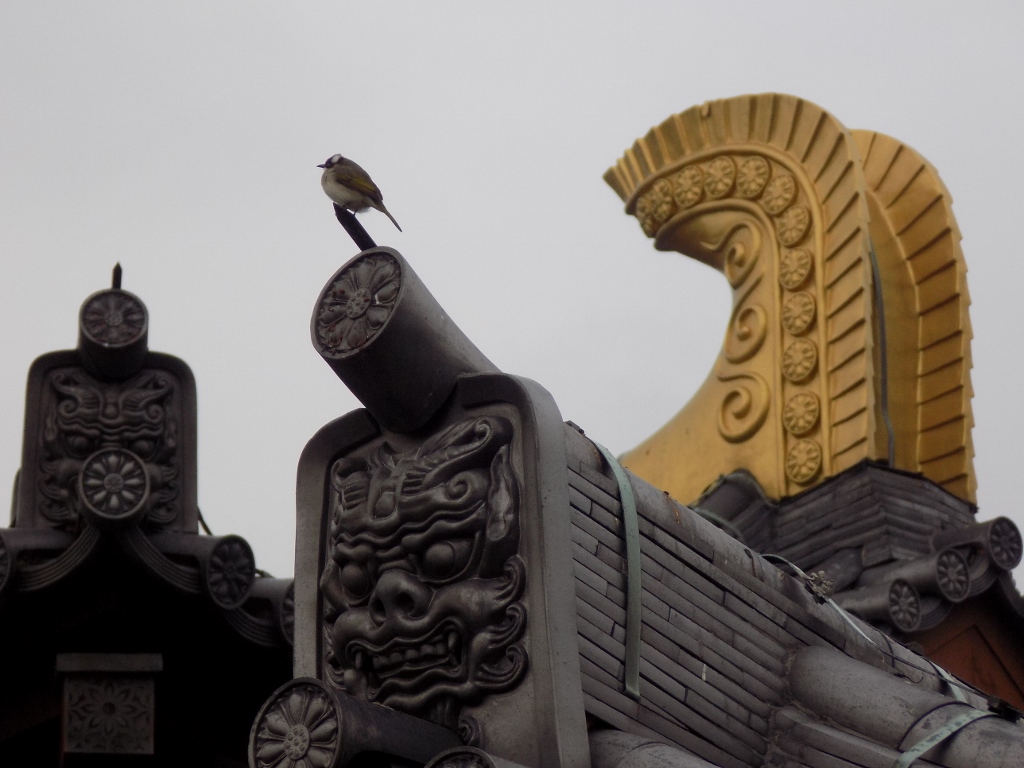 Chi Lin Nunnery, a bird on the roof
Chi Lin Nunnery, a bird on the roof
After the visit to the nunnery, we took the underground to go to the central part of the Kowloon peninsula where we walked to Temple street in which there is a well-known night market. We first had our dinner there and that was good, but as far as the market is concerned it was nothing special. Perhaps, because it was an evening, not a night.
And then, in order not to be late, we took a bus that went to the south end of Kowloon where we got off close to the promenade from which it is possible to watch a light and sound show at 8 o’clock each evening. Namely, since 2004, they started organizing these light and sound “performances” called A Symphony of Lights. Over time, numerous buildings on the island of Hong Kong joined the show by either only being lit or by being used for directing light beams from them. This is all best seen from the side of Kowloon, where parallel to the lights coming from the other side of the strait there is music playing. And it all lasts for 14 minutes. I edited a significantly shorter video clip, but it appears almost as a silent movie, since the music had troubles reaching my camera. It was probably the question of the spreading of the sound.
Although this show is marketed as spectacular, we did not find it particularly overwhelming. The view at the buildings reflecting in the rippling water which are lit one way or another anyway is impressive enough. Still, we were glad that we saw this, too.
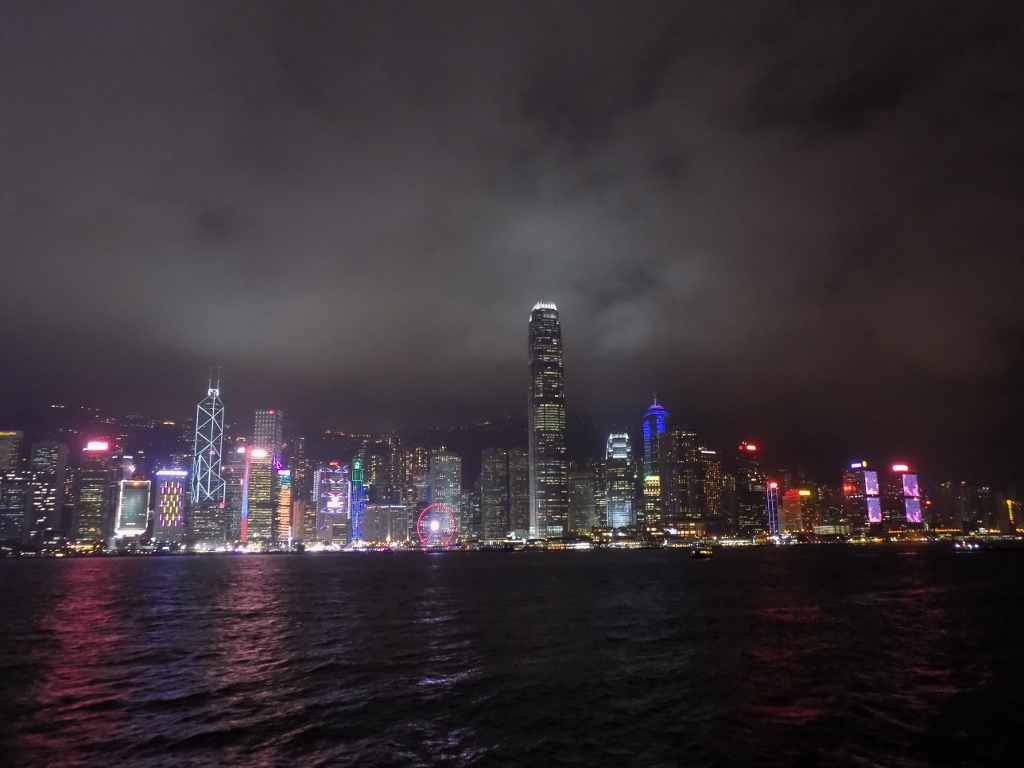 Night panorama of Hong Kong, view from the shores of Kowloon
Night panorama of Hong Kong, view from the shores of Kowloon
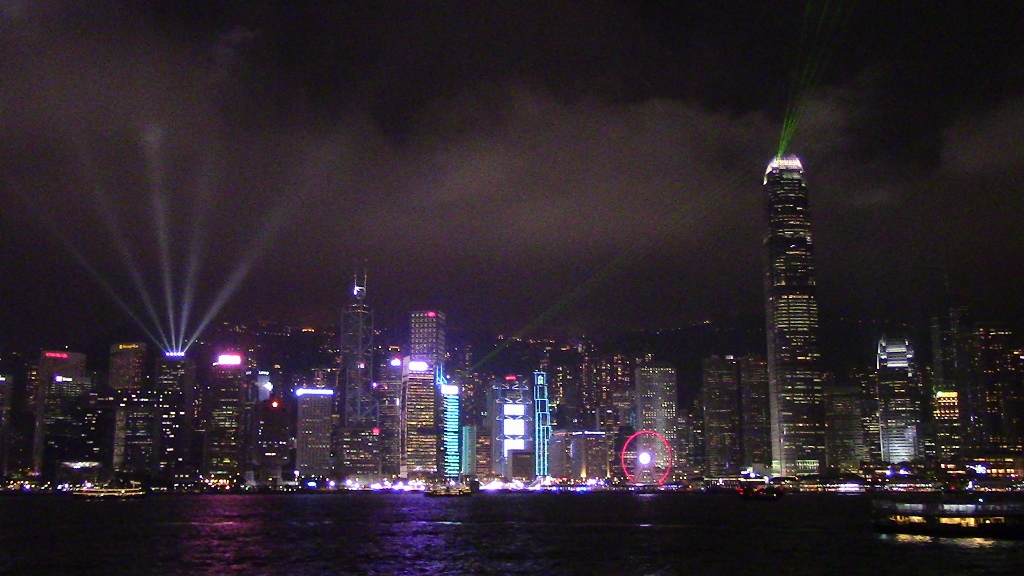 Night panorama of Hong Kong, view from the shores of Kowloon – the show is going on
Night panorama of Hong Kong, view from the shores of Kowloon – the show is going on
We walked around the south part of Kowloon for a little while yet and then went back to the hotel.
The next day we wanted to go to Macao. And we did, but the trip got complicated a little, since we thought it would be enough for us to show up at the boat terminal and it would be all smooth sailing from there. As it turned out we had to wait for more than an hour or rather for one hour and a half. That meant that we reached Macao later than intended and all of our sightseeing was done in a mild haste, but we eventually managed to see all we wanted. I had been told by several people that Macao was nothing special and that it was not worth the trouble. I would absolutely disagree. After all, the old part of Macao is in the UNESCO World Heritage List. It is also interesting that Macao has the highest population density in the world. Who would have thought?
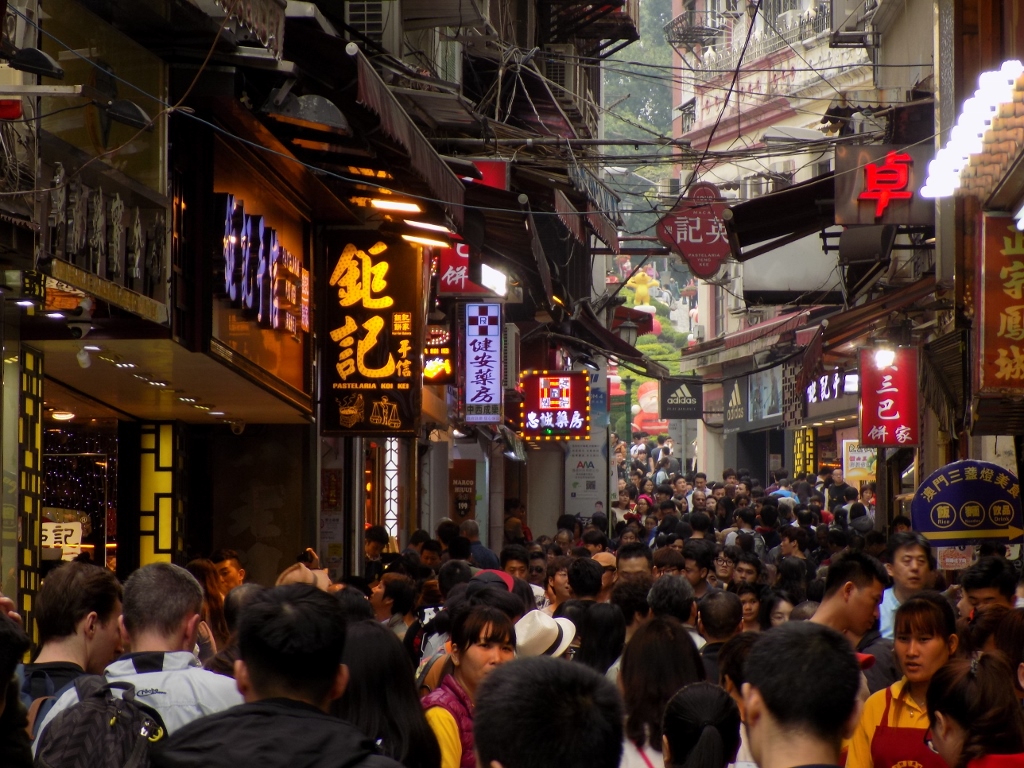 A sight from a street in Macao
A sight from a street in Macao
We first went by boat to a port which is located in the continental part of Macao, there we visited what we could and then we took a city bus going to the south, i.e., to the island. In the evening we went back to Hong Kong from the other port that is located on the island.
Just like Hong Kong, nowadays Macao is also a part of the People’s Republic of China, with a large degree of autonomy. Still, unlike Hong Kong which used to be in the hands of the Brits, Macao was ruled by the Portuguese who returned this former colony of theirs back to China in 1999 with a mutual agreement about the whole thing. The Portuguese influence is still visible, which is logical after 400 years the Portuguese spent here, but today Macao is perhaps best known as a gambling centre, taking into account the number of casinos that either already exist there or that are being built at an accelerated pace.
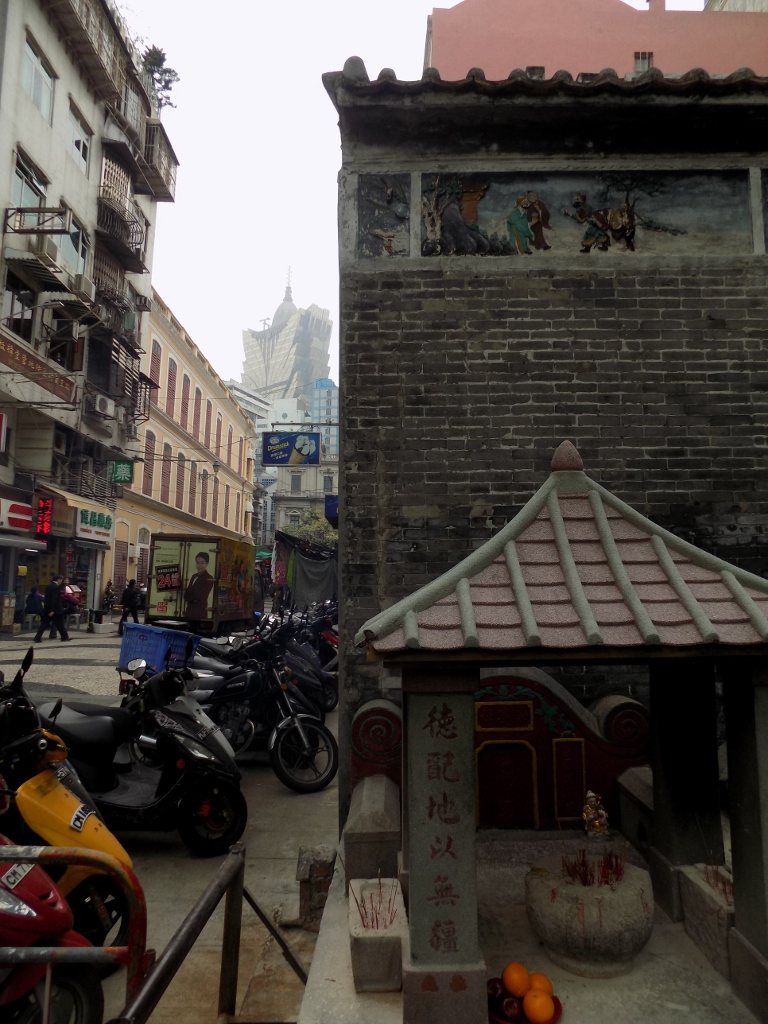 A sight from the old part of Macao – the Sam Kai Vui Kun Temple, with the Grand Lisboa hotel and casino in the background
A sight from the old part of Macao – the Sam Kai Vui Kun Temple, with the Grand Lisboa hotel and casino in the background
Macao consists of a north part that is located on a peninsula attached to continental China and a large island in the south. It is interesting that there actually used to be two islands – Taipa and Coloane. In 2005, the works were completed on filling out the sea between these two islands, that section is called Cotai, and a new island was obtained – Taipa, Coloane and Cotai. Not a very imaginative name.
So, our plan was to visit both parts of Macao. We took a city bus from the port and reached the historic centre where our goal was to get to the Ruins of St Paul’s. We first started from the Senado Square (Largo do Senado), from where it is possible to visit it all nicely following pedestrian streets.
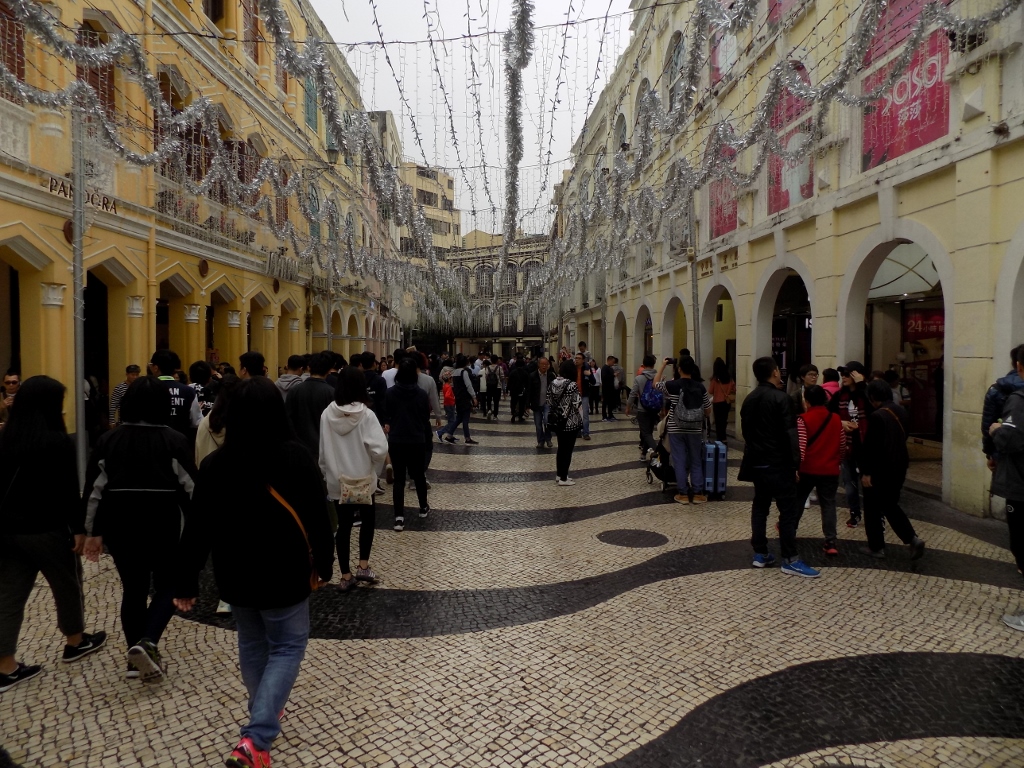 Largo do Senado street
Largo do Senado street
As we were walking along the streets in the centre, we enjoyed the blend of Portuguese and Chinese elements which we saw both in the architecture and in the food that was being sold along the way. What was particularly interesting was that vendors allow the food to be tried. Not only do they allow, but they actually offer proactively. We tried pressed meat sold in boards and the meat, naturally, contained sugar! And we also tried some sweets, such as different types of biscuits and snacks. Some were great, with lots of nuts, and I particularly liked candied ginger in coconut flour. Still, I also had to try biscuits with the taste of pork. It is better when they are separated.
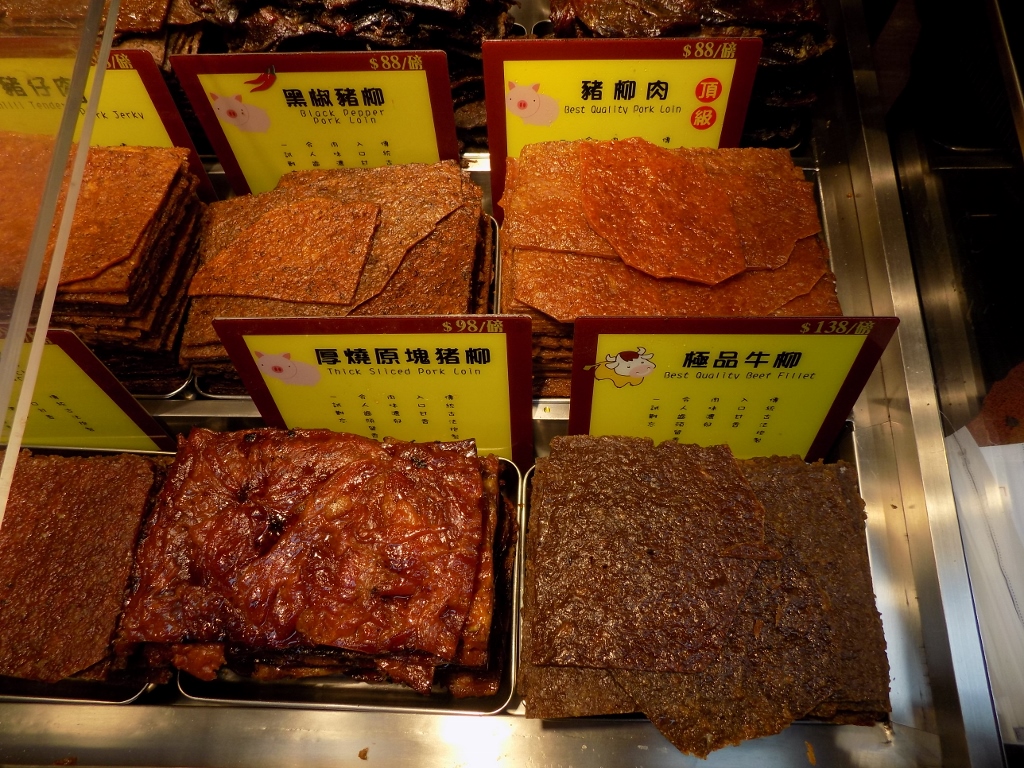 Pressed meat boards
Pressed meat boards
Soon we reached the Ruins of St. Paul’s which is one of the symbols of Macao. These are remains of a church built in the 17th century that was destroyed by fire in 1835 during a typhoon and today only its south facade may be seen. Admittedly, there are also the crypts built by the Jesuits while they were constructing the church, but they appear less impressive.
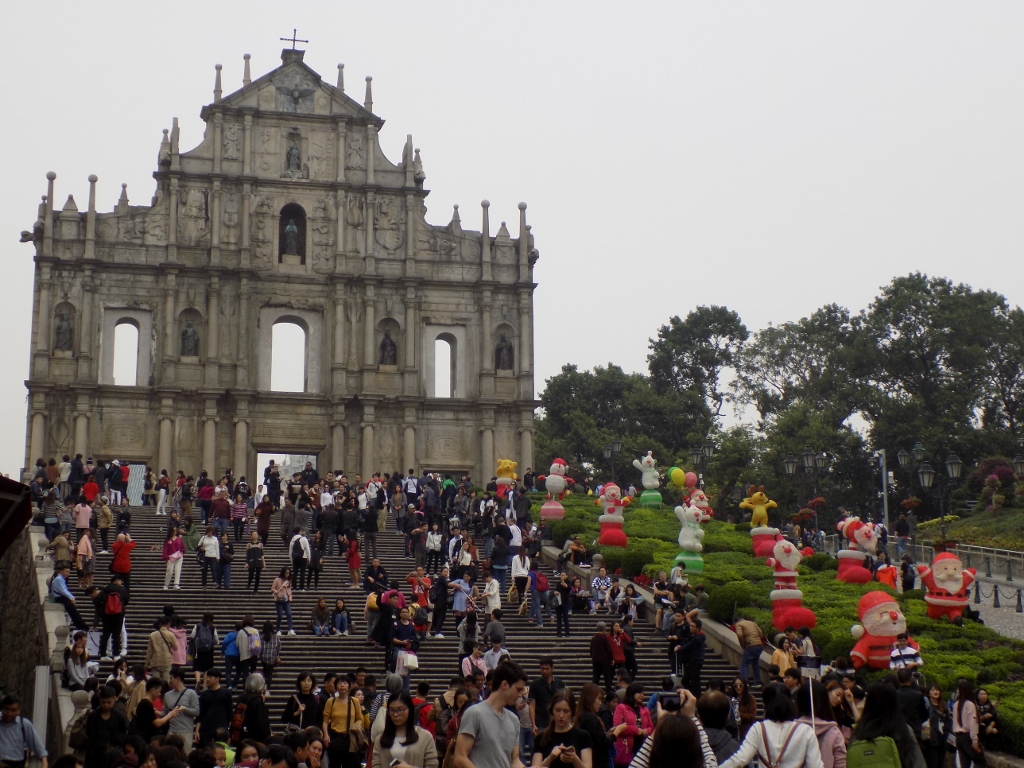 Stairs leading to the top of an elevation where the Ruins of St. Paul’s are
Stairs leading to the top of an elevation where the Ruins of St. Paul’s are
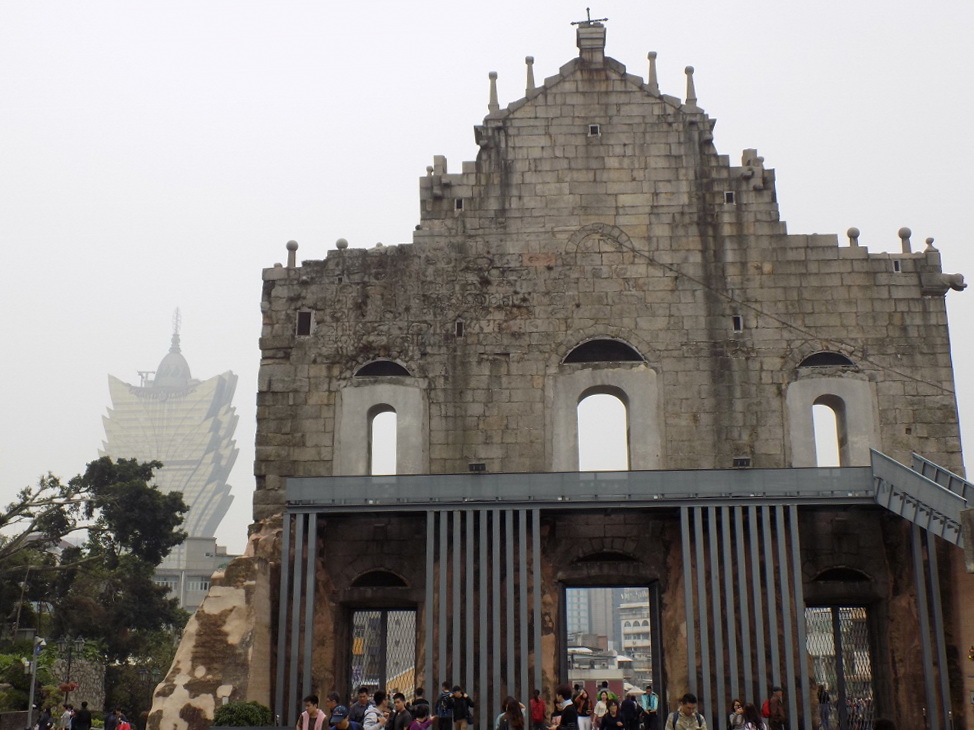 Ruins of St. Paul’s seen from the “back” side, with the Grand Lisboa hotel and casino, the highest building in Macao, to the left
Ruins of St. Paul’s seen from the “back” side, with the Grand Lisboa hotel and casino, the highest building in Macao, to the left
Along our way we passed a few more interesting places, but as I’ve said we did not have too much time, so we soon walked from the historic centre to one of the larger city bus terminals where we caught bus no. 25 that took us from the peninsula with the historic centre of Macao, over a bridge, to the first section of the “new” island called Taipa (formerly an independent island), then we were taken across Cotai (the new, added section) and finally we reached Coloane (formerly also an independent island). We came there because we wanted to visit the Macao Giant Panda Pavilion.
First we walked for a short while around the place that was being reconstructed in some parts and we also entered a building which contained some kind of a “giant panda”-themed kindergarten. There were no children there, but it was instructive, for there were boards on the walls with basic information about giant pandas. Not all the parts of a mini-zoo were operational either, but we could see the red panda, also called the lesser panda. They appear like a specific combination of cats and bears, and in nature they live in the east of the Himalayas and the south-west of China. There was also the golden snub-nosed monkey, an endemic monkey species linked to central and south-west China. They are truly beautiful.
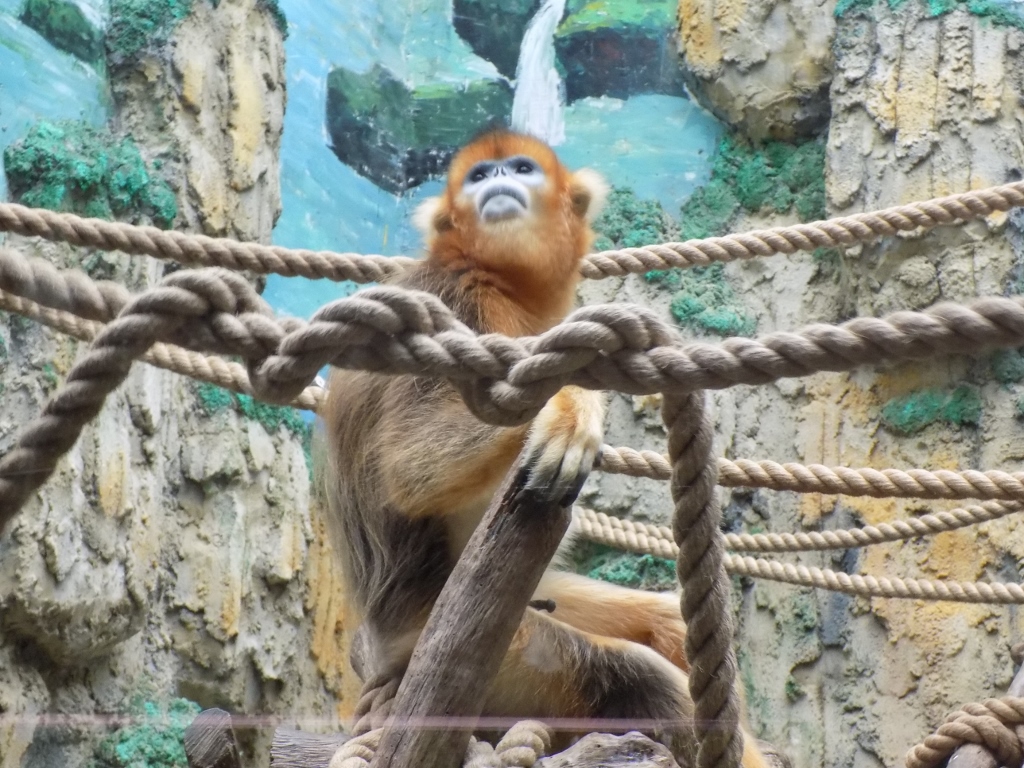 The golden snub-nosed monkey
The golden snub-nosed monkey
As for the pandas, they are gorgeous – round, black and white, cute, and they just sit around munching on their bamboo. In this pavilion we saw four pandas divided into two spacious enclosures. Although I was really glad to see specimen of these rare species, I was on the other hand very sorry to see them locked up. In spite of their space here being made with care and a lot of details, still their life in a zoo makes me sad.
 Giant panda
Giant panda
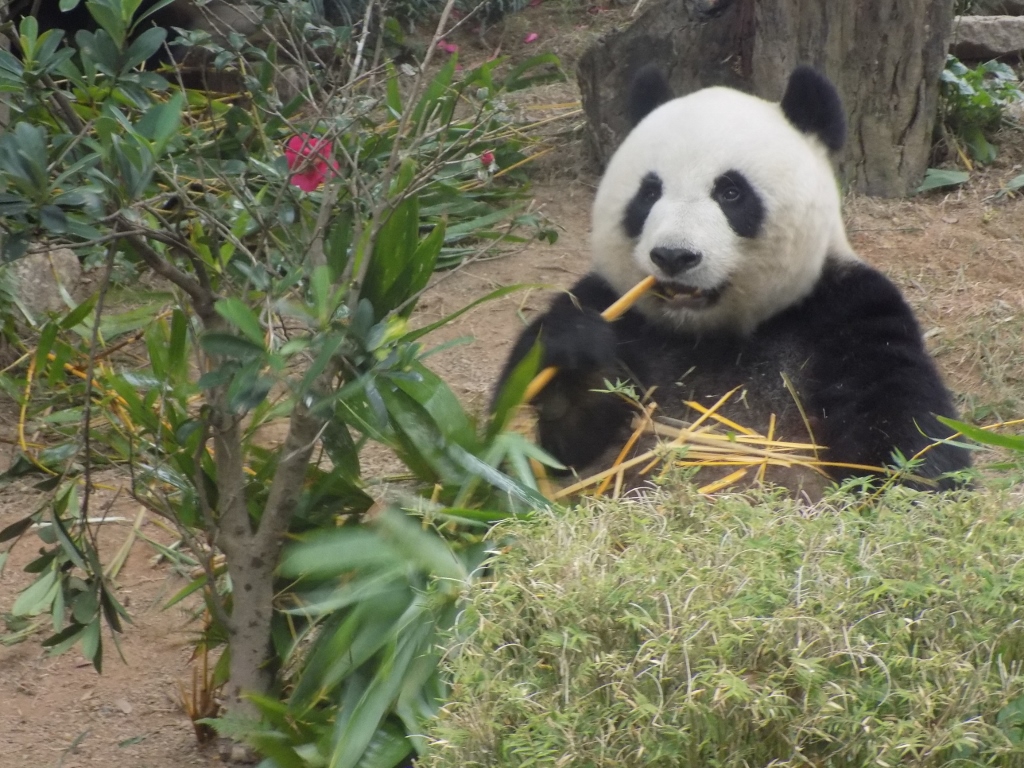 Giant panda
Giant panda
And then we went back to the new part of the island, Cotai, for this is the casino epicentre. Having in mind a recommendation we had been given, we went to a casino with the Venice theme, which is by the way the biggest casino in the world. Our plan was to eat there before heading back to Hong Kong. In this way, we had a very diverse programme in Macao for a period of a little more than half a day – history, mixture of cultures, nature, as well as commercialism and flaunting of wealth.
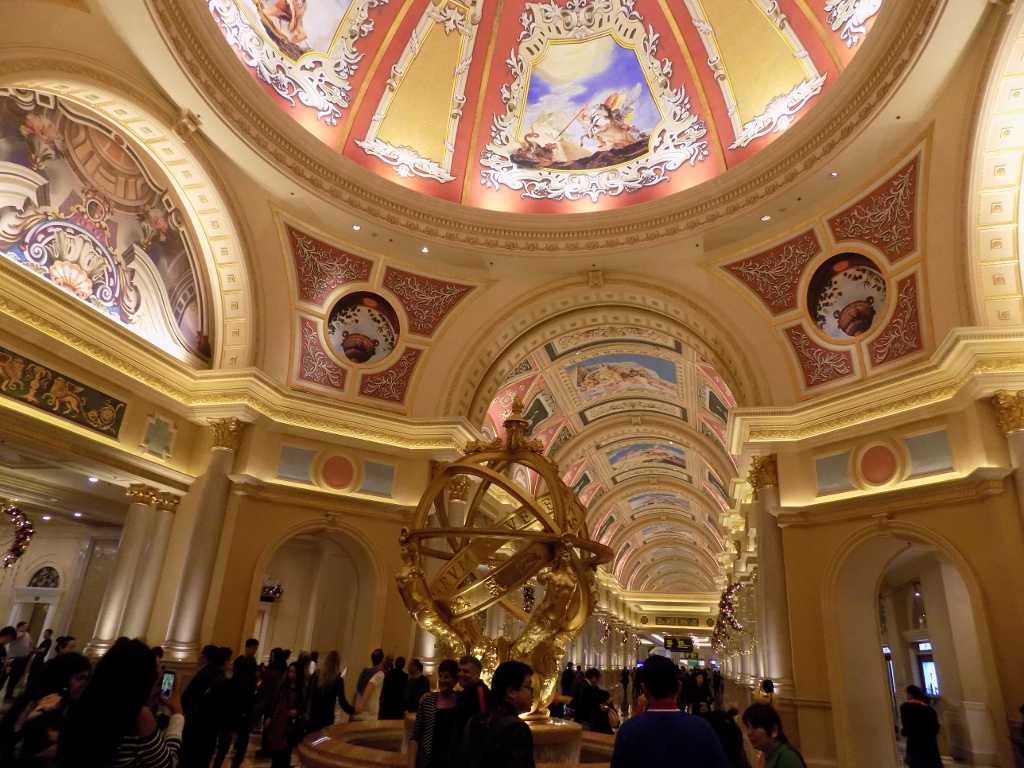 The Venetian Macao casino
The Venetian Macao casino
Like in the case of zoos, in the case of the Venetian Macao casino (and I guess the same would be in any other casino), I had mixed feelings. On the one hand, it is all impressive, the most beautiful parts of Venice had been selected and put here at one site, and at the same time, since I’d seen the original and I know the original exists, I was aware all the time that this was just a copy with the goal to dazzle (literally and metaphorically) the visitors with its size, invested money and the representation of wealth, in order for the visitors to part more easily from their own money. Both Sneza and I are immune to gambling, but we are not immune to food, so we went to one of the Chinese restaurants belonging to the casino and had a very nice meal there.
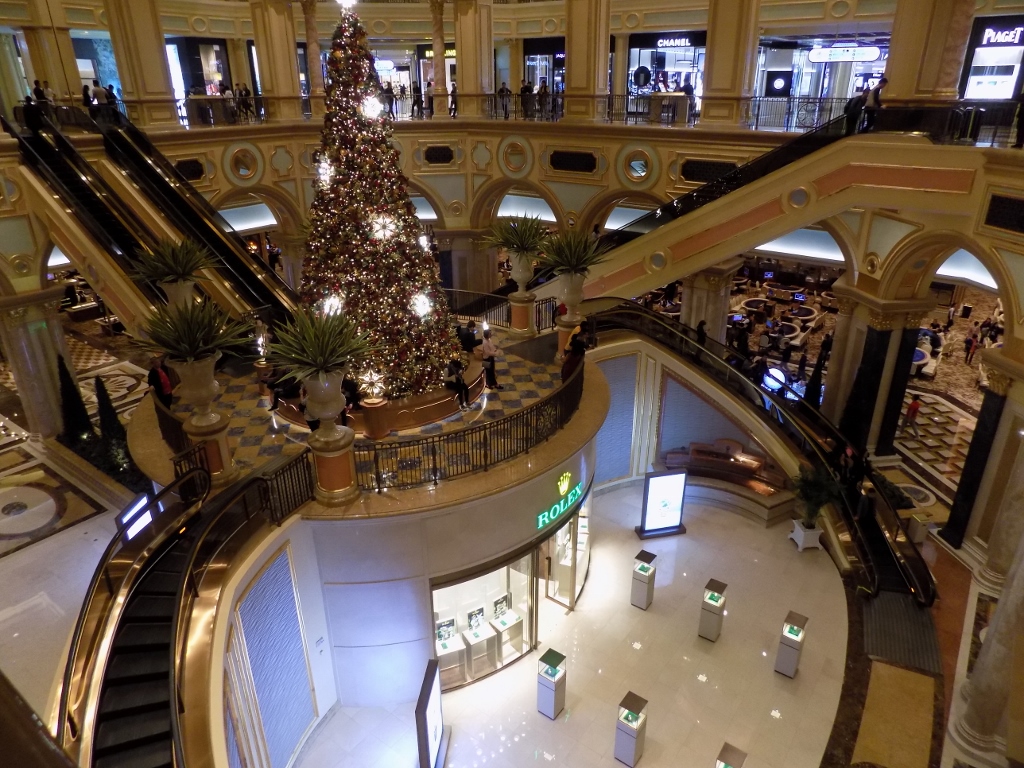 The Venetian Macao casino, of all the shops I was mostly impressed by the escalators with a circular motion (what can I do, I’m a sucker for cheap fun)
The Venetian Macao casino, of all the shops I was mostly impressed by the escalators with a circular motion (what can I do, I’m a sucker for cheap fun)
Still, what was perhaps the most important thing for the two of us at this point in time was that right after coming to the casino, we bought at the casino’s reception return tickets to Hong Kong, in order to make sure that we wouldn’t wait for an hour and a half again. At the same time, we found out that there was free bus transportation from the casino to the Taipa port, so we took advantage of that and soon we were back in Hong Kong again.
There we walked over to the city port and caught a ship that belongs to the Star Ferry company in order to get to Kowloon. It is indeed a beautiful sight to see the lit buildings of Hong Kong, so this short trip served in lieu of a night sightseeing tour of the Hong Kong port (it needs to be booked a few days in advance). While in Kowloon, we walked a little along Canton road which is full of exclusive shops of the most expensive brands in the world (that produce wardrobe, shoes and similar things) and I don’t remember seeing such concentration even in Paris, London or New York. There are, of course, shopping malls around that offer less expensive items, but what they all have in common is that everything glows and shines. We did not stay there for too long, though, and returned to the port where we embarked on a ship sailing to the Wan Chai port, thus additionally enjoying the beautiful views of Hong Kong. At the same time, this port was significantly closer to our hotel and soon we were in our room where we could pack and get ready for the continuation of our trip the next day.
And the next day we moved to Hanoi, for the main destination of our journey was Vietnam.